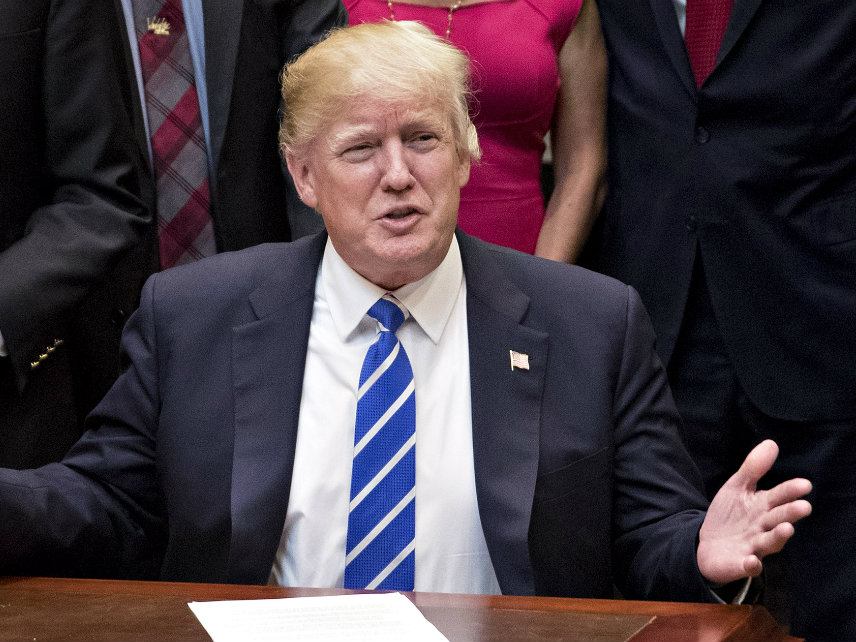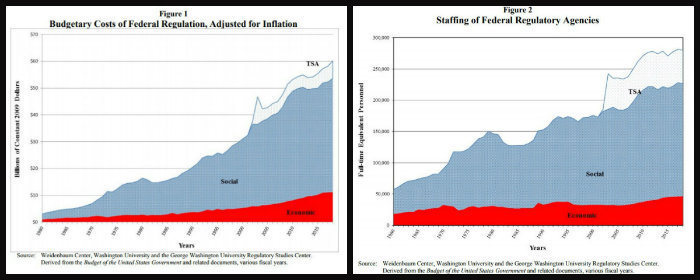Trump's Budget Hikes Regulatory Spending Twice as Fast as Obama's Final Year
Trump is cutting some regulatory costs, but overall spending and staffing levels will increase, thanks mostly to the Department of Homeland Security.

Despite promising to roll back the federal regulatory state, President Donald Trump's first budget proposal would increase regulatory spending by more than 3 percent—double the increase approved by Congress during Barack Obama's final year as president.
If Congress were to enact Trump's budget as written, the federal government's regulatory staff would fall by half of 1 percent, but the total amount of taxpayer money spent by regulatory agencies would climb to $69.4 billion. That's up from $65.9 billion in 2017 and $63.7 billion in 2016, according to researchers at the Weidenbaum Center on the Economy, Government, and Public Policy at Washington University in St. Louis and the George Washington University Regulatory Studies Center in Washington, D.C.
Researchers from the two schools have been tracking the so-called "regulatory budget" since 1959. Regulatory spending by the federal government has increased 20-fold during that time.
This year's report examines 77 different federal agencies involved in regulating social affairs (things like the National Highway Traffic Safety Administration or the Food and Drug Administration) or economic affairs (the Securities and Exchange Commission, the Consumer Financial Protection Bureau, and the like).
The overall increase in regulatory agency spending masks some areas where the Trump administration has proposed cuts. The Environmental Protection Agency, for example, would face $4.1 billion in spending cuts and would lose an estimated 4,000 employees under Trump's budget. In other areas, the administration has taken direct steps to reduce regulations, as when it worked with Congress to kill several major Obama-era regulations with the Congressional Review Act. Trump's appointees at the Department of Education, the Federal Communications Commission, and elsewhere have indicated a desire to wipe more regulations off the books.
The Washington University/George Washington University report isn't counting the number of regulations, though. Instead, it's counting the actual cost of enforcement, in terms of taxpayer money spent and government employees hired.
Under that calculus, Trump's regulatory cuts are being offset by the president's plan to spend more money and hire more people to regulate immigration. "Regulators who focus on immigration, such as those at the Coast Guard, Immigration and Customs Emforcement, Customs and Border Patrol, and the Transportation Security Administration are budgeted for increases of around 10 percent or more next year," Susan Dudley, one of the report's authors, noted in a summary posted at Forbes.
Rather than cutting the regulatory state, then, Trump's first budget plan is better understood as a shifting of regulatory priorities—a shift in which the increases overwhelm the cuts.
The biggest increases are within the Department of Homeland Security, where regulatory agencies would see a 13.7 percent increase ($4.1 billion, equal to the cuts at the EPA) this year, followed by a planned 5.9 percent increase next year. Staffing at DHS is expected to grow by more than 2,300 people under Trump's budget.

One big caveat: All of this assumes that the budget eventually adopted by Congress will include the cuts proposed by the White House. That is, to put it mildly, far from guaranteed.
Trump's presidency has been unique in many ways, but his regulatory budget follows a long-term trend. According to the report, Obama increased federal regulatory spending by 13 percent ($6.8 billion) during his eight years in office, while staff levels increased by 7 percent. George W. Bush set a faster pace, hiking regulatory spending from about $25 billion in 2000 to more than $47 billion by 2008, an increase largely driven by the creation of the Department of Homeland Security and the TSA during his presidency.
When Trump accepted the Republican nomination in Cleveland last year, he promised that "we are going to deal with the issue of regulation, one of the greatest job-killers of them all." In some ways he's done that. But his budget still fits snugly into a 60-plus-year trend of a federal government that spends more of your money to stick its nose into more of your business.


Show Comments (35)